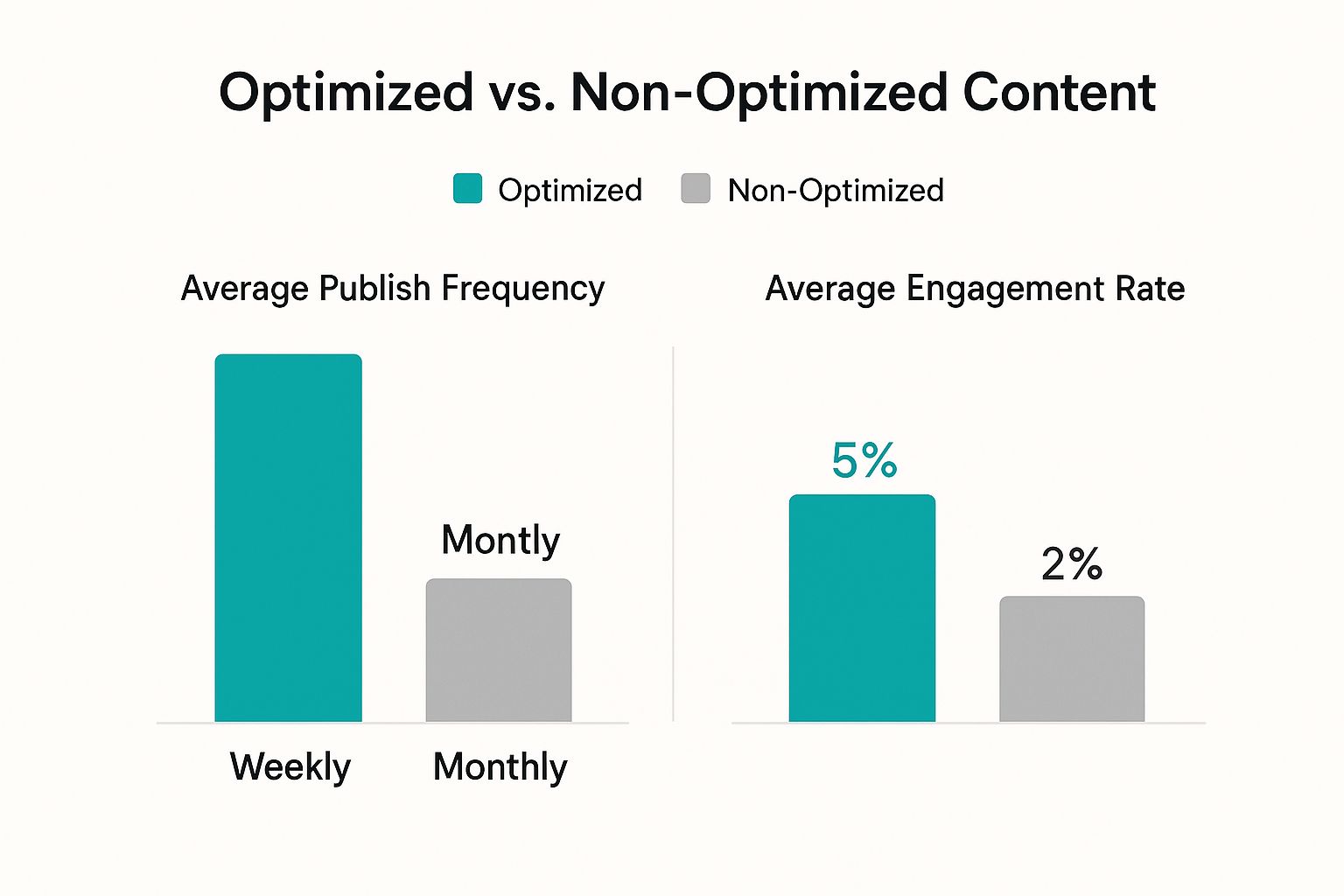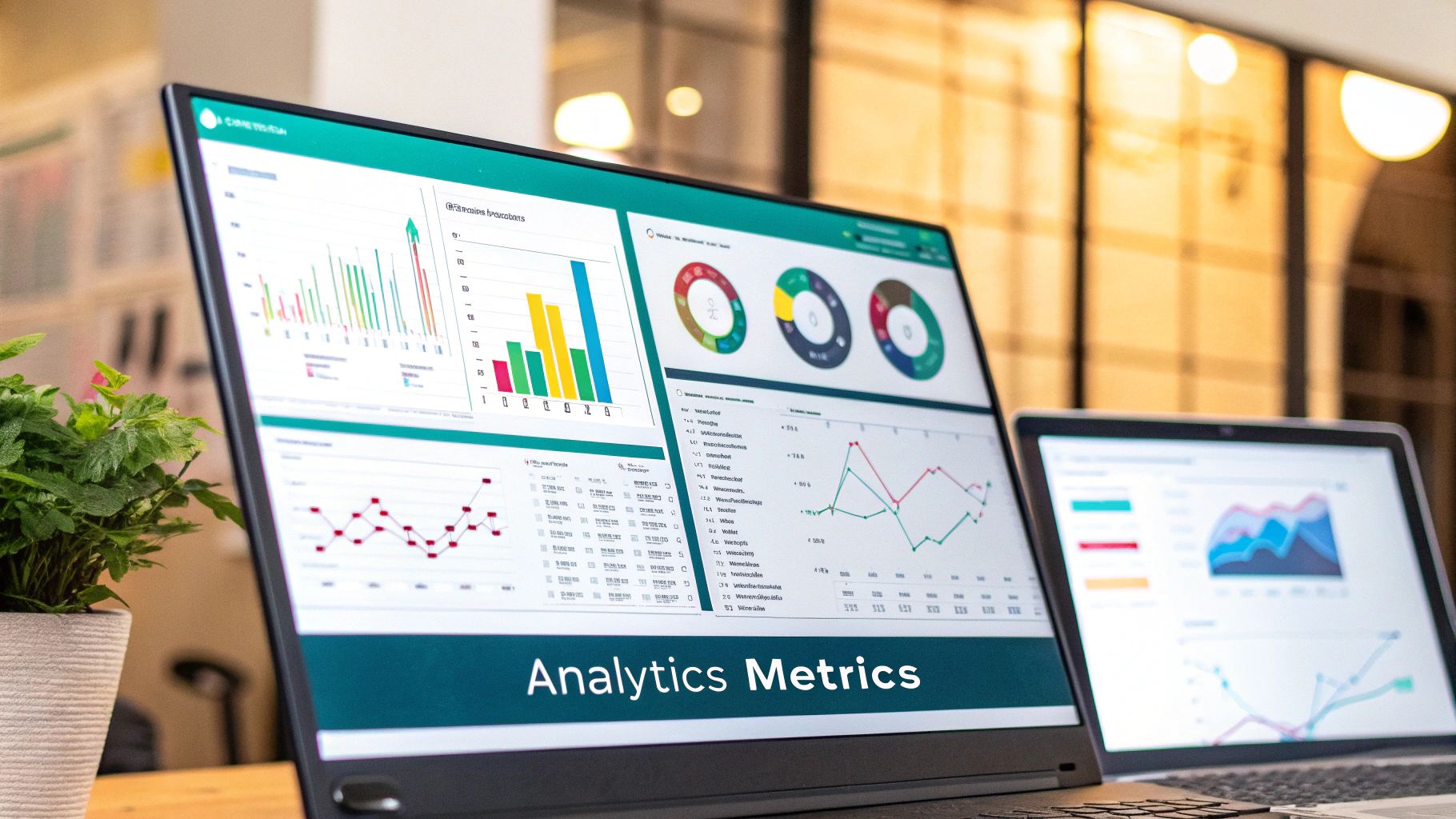Think of content optimization as more than just a task on your to-do list. It’s the ongoing work of making sure every single piece of content you've published is pulling its weight. We’re not just talking about churning out new articles; we’re talking about refining what you already have to make it more relevant, more visible, and a better experience for your readers.
Building Your Content Optimization Foundation

Before you start tweaking and updating, you need to know exactly where you stand. Real content optimization isn't about guesswork; it's about building a solid foundation based on clear benchmarks and a genuine understanding of your current performance.
This is your diagnostic phase. You wouldn't start a road trip without checking your fuel gauge and looking at a map, right? The same logic applies here. The goal is to get a clear picture of what’s working well and what’s holding you back.
The Core Pillars of Your Strategy
To build this foundation, I always focus on three critical pillars. Each one is a crucial part of a healthy content machine, and they all work together to produce real, measurable results.
- User Intent Alignment: Does your content actually answer the questions your audience is asking? This is about getting inside their heads and understanding the why behind their search, not just matching keywords.
- Technical SEO Health: You could have the best article in the world, but if search engines can't crawl, index, and understand it, it might as well not exist. This covers the essentials like site speed, mobile-friendliness, and clean code.
- Performance Benchmarking: You have to know what success looks like. I'm talking about tracking hard metrics like organic traffic, keyword rankings, and conversion rates to see what’s truly moving the needle.
A baseline audit is your first step toward impactful change. It's where you uncover quick wins—like an underperforming post with high potential or a landing page with a technical glitch—that can deliver immediate improvements with minimal effort.
A structured approach like this turns optimization from a shot in the dark into a deliberate, strategic process. And a huge part of that process is, of course, search engine optimization (SEO). It's a non-negotiable cornerstone of any modern marketing effort.
In fact, its importance is almost universally acknowledged. As of 2025, approximately 93% of companies worldwide report that SEO has a positive impact on their website's performance and helps them hit their marketing goals. That number alone shows just how vital good SEO practices are for boosting visibility. If you're curious, you can dig into more content marketing statistics and trends to see the bigger picture.
Conducting a Baseline Audit
When I take on a new project, the very first thing I do is a baseline audit. I’m hunting for the low-hanging fruit—those articles that are almost great but just need a little nudge to get over the finish line.
For example, I'll dive into Google Search Console to find pages with high impressions but a dismal click-through rate. That's a classic sign that a compelling new title tag or meta description could work wonders. Or, I’ll look at top-performing posts from a year ago to see if they’re suffering from content decay.
This foundational work is what sets the stage for everything else. It creates a powerful engine that drives actual business results, not just vanity metrics.
To help you get started, here's a simple breakdown of the core pillars that guide a successful content optimization strategy. Think of this as your roadmap for turning existing content into a high-performing asset.
Core Pillars of Content Optimization
| Pillar | Primary Goal | Key Actions |
|---|---|---|
| User Intent Alignment | Match content to the user's underlying need or question. | – Research "People Also Ask" and related searches. – Analyze top-ranking competitor content. – Update content to be more comprehensive and direct. |
| Technical SEO Health | Ensure search engines can easily find, crawl, and index your content. | – Check for crawl errors in Google Search Console. – Optimize page load speed and mobile usability. – Implement or clean up structured data (schema). |
| Performance Benchmarking | Establish a data-driven baseline to measure growth. | – Track keyword rankings for target terms. – Monitor organic traffic, bounce rate, and time on page. – Set up and track conversion goals (e.g., sign-ups, downloads). |
By systematically addressing each of these pillars, you're not just making random updates; you're building a repeatable process for sustainable content growth. This is how you move from simply publishing content to owning a powerful marketing channel.
Breathing New Life Into Your Existing Content

It’s easy to get caught up in the never-ending cycle of creating new content. But what if I told you your best growth opportunities are probably hiding in plain sight, tucked away in the articles you've already published? That’s where a proper content audit comes in. It’s the process of turning your archive from a dusty library into a high-performance growth machine.
This isn’t about just glancing at page views. A real audit is a deep dive. We're talking about digging into each article's relevance, accuracy, search performance, and, most importantly, its ability to actually do something for your business. This is the bedrock of any smart content marketing optimization strategy.
The Keep, Improve, or Trash Framework
The whole point of an audit is to make clear, data-driven decisions about what to do next. To keep things simple and avoid getting emotional about a post you spent weeks on, I sort every piece of content into one of three buckets. It's a straightforward framework that forces you to be honest about what's working and what's not.
- Keep: These are your all-stars. They're the high-performing, relevant, and accurate articles that consistently bring in traffic and conversions. For now, leave them be.
- Improve: This bucket is where the real gold is. This is content that has potential—maybe it's lingering on the second page of Google, gets a good number of impressions, or covers a topic that never gets old—but it's just not hitting its full stride.
- Trash: This is for content that's completely outdated, irrelevant, or performs so badly that it's not worth the time to fix. Don't be afraid to prune your content garden. Getting rid of dead weight can actually boost your site's overall authority in Google's eyes.
I see so many people make the mistake of clinging to every single article they've ever published. Your website isn't a museum; it's a strategic tool. Being ruthless about what to delete or redirect is just as critical as knowing what to update.
Just last year, I was looking at a client's two-year-old blog post that was suffering from classic "content decay." It used to be a winner, but the info was stale. We gave it a complete refresh—updated stats, added new sections to match current search intent, and tightened up the on-page SEO. The result? A 50% traffic lift in under two months.
Finding the Clues That Lead to Action
To sort your content effectively, you need to look beyond vanity metrics. You need to connect the dots between the data and your actual business goals.
I always start with a simple spreadsheet to track the vitals for my most important pages.
| Metric | Tool I Use | What It Actually Tells Me |
|---|---|---|
| Organic Traffic | Google Analytics 4 | Shows me my top performers and, crucially, which pages are losing steam. |
| Keyword Rankings | Google Search Console | Pinpoints my "almost famous" pages ranking just off page one—prime targets for a refresh. |
| Conversion Rate | Google Analytics 4 | Tells me which content is actually making money or generating leads. |
| Backlinks | Ahrefs or Semrush | Helps me spot authoritative pages that are perfect for internal linking or repurposing. |
Laying the data out like this helps patterns jump right out at you. A landing page with tons of traffic but a terrible conversion rate probably needs a stronger call-to-action. An article with a boatload of backlinks but declining traffic is screaming for an update.
This focused approach isn't just theory; it gets results. Research shows that marketers who take the time to update existing content see a 53% increase in engagement. What's more, 83% of marketers report that creating higher-quality content less often is far more effective than just churning out post after post. You can dig into more of these findings on content marketing optimization yourself. The data is clear: strategic refinement beats sheer volume every time.
Using AI to Enhance Your Content Workflow
Let's be clear: AI isn't some far-off concept anymore. It's a real, practical tool that can seriously level up your content marketing. The key is to treat it like a brilliant assistant, not an autopilot. It's here to augment your skills and creativity, not replace them. When you get this right, you produce better work, faster.
Think of an AI tool like a brainstorming partner that’s always on and never runs out of steam. Instead of a lazy prompt like "blog topics," I get specific. For instance, I might ask a tool like LLaMO Pro to generate a full topic cluster around "content marketing optimization for e-commerce." I'll ask for a pillar page concept, three supporting blog posts, and five social media hooks. Just like that, I have an interconnected content plan ready to go.
From Ideas to Structured Outlines
Once you've landed on a topic, an AI can help you build out the entire skeleton of the article. Again, a good prompt is everything. Don't just ask for an "outline." I've found much more success with something like: "Create a detailed outline for a blog post titled 'A Beginner's Guide to Content Audits.' Include H2s and H3s, add bullet points for key data, and draft a blockquote that summarizes the main takeaway. Make sure the structure flows logically from identifying problems to implementing solutions."
This simple step can save hours of staring at a blank page. It gives you a clear roadmap before you’ve even written a single sentence.
The image below really drives home the difference between content that's been strategically optimized and content that's just been published without much thought.

As you can see, the data is pretty stark. Optimized content doesn't just pull in way more engagement; it also supports a more sustainable and frequent publishing schedule.
To better illustrate how AI fits into your day-to-day work, here’s a look at some practical applications across the entire content lifecycle.
Practical AI Applications in Content Optimization
| Content Stage | AI-Powered Task Example | Expected Outcome |
|---|---|---|
| Ideation & Research | Generate a list of questions your target audience asks about "SaaS pricing models." | A list of high-intent topics that directly address user pain points. |
| Content Creation | Draft an introduction and conclusion for an article on "The Future of Remote Work." | Well-structured starting and ending points, saving time on initial drafting. |
| Optimization & SEO | Analyze a draft and suggest semantic keywords related to the main topic of "email marketing automation." | Improved on-page SEO and better alignment with search engine algorithms. |
| Post-Publication | Summarize user comments from a blog post to identify common themes and follow-up questions. | Actionable insights for future content updates or new article ideas. |
This table shows just a few examples, but the possibilities are expanding every day. The goal is always to use AI to handle the grunt work so you can focus on the bigger picture.
AI-Powered Editing and Analysis
Beyond just creation, AI is a powerhouse for refining your work. It can help decipher the user intent behind complex search queries, which is crucial for aligning your content with what people are actually looking for. This is the heart of effective content marketing optimization.
Here are a few ways I put AI to work as my personal editor and analyst:
- Readability and Tone Check: I'll drop a draft into an AI tool and ask it to flag complex sentences or suggest ways to make the tone more conversational and approachable.
- SEO Suggestions: I often ask it to find related terms. For example, "What are some LSI keywords for 'content audit framework' that I should include?"
- Data-Driven Personalization: AI can spot patterns in user data and suggest how to tailor specific sections of your content, making your message hit home with different audience segments.
The real magic of AI in content marketing is its ability to do the heavy lifting—the data crunching and repetitive tasks. This frees you up to focus on what humans do best: high-level strategy, genuine creativity, and building real connections with your audience.
This shift is happening fast. The adoption of AI for content marketing is absolutely booming. Projections show that by 2025, a staggering 90% of content marketers will be using AI tools in their daily workflows. That's a huge leap from just 64.7% in 2023. You can read more about the growth of AI in content strategy to see just how quickly these tools are becoming standard. By getting on board now, you aren't just keeping up; you're building a smarter, more efficient content engine for the future.
Maximizing Reach with Smart Distribution
Let's be honest: even the most brilliant content is useless if no one sees it. So many teams fall into the "publish and pray" trap, and it's a surefire way to watch your hard work and resources go down the drain. Real content marketing optimization isn't just about what you create; it’s about having a smart, proactive plan to get it in front of the right people.
Without a distribution strategy, you’re just shouting into the void. A solid plan gives every article, video, or guide its best shot at finding an audience and actually making an impact. It’s time to move beyond just hitting "publish" and hoping for the best.
Building Your Multi-Channel Promotion Plan
First things first: where does your audience actually live online? The key is to take one core piece of content and "atomize" it—breaking it down into smaller, bite-sized assets perfect for different channels. This is how you get the biggest bang for your buck on the time you've already invested.
Think about one of your in-depth pillar posts. You can easily spin that into:
- A quick email newsletter: Pull out the main takeaways and give your subscribers a direct link to the full piece.
- A batch of social media posts: Design some eye-catching quote graphics, snip a few short video clips, or create a data-heavy carousel for platforms like LinkedIn or Instagram.
- A script for a short video: Turn the key points into a snappy video for YouTube or TikTok. Don't forget, video currently delivers the highest ROI of any content format.
This isn't about creating more work; it’s about working smarter. This multi-channel approach breathes new life into your content and dramatically extends its reach.
The most overlooked part of content marketing is this: creation is only half the battle. Your distribution efforts deserve just as much strategy and resources as your content creation. What good is a masterpiece if it’s locked away in a vault?
Strategic Outreach and Amplification
Once you’ve handled your own channels, it’s time to look outward. Strategic outreach is essential for tapping into new audiences. This means identifying and building real relationships with influencers, publications, and online communities where your target customers already place their trust.
Paid amplification can also be a powerful tool, especially on professional networks. A targeted ad on LinkedIn promoting a high-value whitepaper or a new case study can put your best content directly in front of the decision-makers you need to reach.
Remember, content marketing generates three times more leads than old-school advertising and costs 62% less. If you reinvest even a small fraction of those savings into targeted promotion, you can multiply your results. Every outreach email and every small ad campaign is a deliberate move to make sure your content does the job it was created to do.
Measuring Performance and Proving ROI

Here's where the rubber meets the road. All the strategy and creation in the world doesn't mean much if you can't show it’s working. If you're not measuring your content's impact, you're flying blind, and justifying your budget becomes an uphill battle.
We have to look past the easy-to-find vanity metrics. Sure, a spike in page views or a flurry of social likes feels great, but they don't pay the bills. The real goal is to connect your content directly to business growth, and that requires digging into the data that truly matters.
Moving Beyond Vanity Metrics
To really prove your content's worth, you have to connect it to tangible business outcomes. This means asking a fundamentally different question: not "How many people saw this?" but "What valuable action did they take after seeing it?" This shift in thinking is what separates good marketers from truly effective ones.
Your key performance indicators (KPIs) need to reflect this business-first mindset. Forget the fluff and focus on what moves the needle.
- Conversion Rate: What percentage of your readers actually did something? Did they sign up for your newsletter, download that whitepaper, or book a demo? This is your action metric.
- Lead Quality: It’s not just about getting leads; it's about getting the right ones. This often means working closely with your sales team to find out if the leads from your content are actually a good fit for the business.
- Content-Assisted Revenue: This is the ultimate KPI. How much revenue can you trace back to a specific article or guide? Answering this question provides undeniable proof of your content's value.
A truly optimized content strategy doesn't just pull in an audience—it guides them on a journey. Your analytics should tell that story, drawing a clear line from a blog post all the way to a sale, proving your content's contribution to the bottom line.
Building Your Performance Dashboard
To keep an eye on these crucial metrics, you need a central command center. A well-configured Google Analytics 4 (GA4) account is perfect for this. The key is to get out of the default reports and build custom dashboards that mirror your specific business goals.
For instance, you can set up a custom exploration report in GA4 that follows the user's path from a specific blog post. By analyzing the event path, you can pinpoint which articles are most effective at pushing users toward your key conversion pages. This kind of insight is gold for planning your future content.
A simple but powerful dashboard setup might include:
- A Landing Page Report: Filter this to show only your blog or content pages, not your entire website.
- Key Conversion Events: Add columns for your main conversion goals (e.g.,
form_submission,lead_generated, ordemo_request). - Engagement Metrics: Bring in metrics like Engaged sessions and Average engagement time to quickly see which pieces are holding people's attention.
Understanding Content Attribution
Finally, remember that the customer journey is rarely a straight line. Someone might read one of your blog posts this week, see a social media ad next week, and finally convert by searching for your brand directly. Standard last-click attribution gives 100% of the credit to that final search, completely ignoring the hard work your content did earlier.
This is why you have to explore different attribution models. Models like "linear" or "time decay" available in GA4 do a much better job of distributing credit across all the touchpoints that influenced a conversion. Adopting a more sophisticated attribution model helps you prove that your top-of-funnel content, while rarely the final click, plays a vital role in nurturing leads and driving long-term growth.
By combining meaningful KPIs, custom dashboards, and a smarter approach to attribution, you’ll have everything you need to build an undeniable business case for your work. You'll be able to show exactly how your content marketing optimization is fueling the business, armed with the data to back it up.
Got Questions About Content Optimization? Let's Clear Things Up.
Even the most seasoned marketers run into questions when they start digging into their content. Getting clear, practical answers is what separates a stalled strategy from one that’s firing on all cylinders. Let's tackle a few of the questions I hear most often.
How Often Should I Really Be Auditing My Content?
This is a big one. No one wants to spend all their time auditing, but you can't just set it and forget it. I’ve found the best rhythm is a major, deep-dive audit once a year. This is your big-picture review where you look at everything.
But to stay ahead of the curve, you should also be doing lighter, quarterly check-ups. Focus these on your top-performing content and, just as importantly, the pieces that are starting to slip. This is how you spot content decay early and keep your winners winning.
Think of it like this: your annual audit is the full physical, and the quarterly reviews are your regular wellness checks.
Is This a Tug-of-War Between SEO and User Experience?
It can definitely feel that way, but it shouldn't be. The truth is, the best content marketing optimization happens when you realize SEO and user experience are two sides of the same coin.
At the end of the day, Google’s goal is to give its users the best possible answers. If you focus on creating genuinely helpful, engaging content for your human audience, you’re already halfway to great SEO.
Here’s how I approach finding that balance in my own work:
- Write for humans, not bots. Keywords should feel like a natural part of the conversation, not clunky additions you've forced into a sentence. If it sounds weird when you read it aloud, it’s wrong.
- Make it easy to read. Use headings (H2s, H3s), short paragraphs, and bullet points. This helps people scan for the information they need, and it also gives search engine crawlers clear signposts to understand your content’s hierarchy.
- Think intent, not just keywords. Ask yourself why someone is searching for a particular phrase. What problem are they trying to solve? Build your content to be the absolute best solution for that need.
The most effective SEO strategy I've ever found is to be relentlessly helpful. Prioritize creating an amazing experience for your reader, and you'll see the rankings start to take care of themselves.
What Tools Do I Actually Need to Get Started?
The sheer number of tools available can be overwhelming. The good news? You don't need a massive, expensive tech stack to make a real impact.
For most teams, a handful of core tools will get you 90% of the way there:
- Google Analytics 4 is non-negotiable for understanding how people are actually interacting with your site.
- Google Search Console is your direct line to Google, showing you what keywords you’re ranking for and flagging technical snags.
- An all-in-one SEO platform like Semrush or Ahrefs is invaluable for everything else, from competitive research to tracking backlinks.
Start with these fundamentals. Once you’ve mastered them, you can explore more specialized tools if you find you have a specific need.
Ready to see how AI perceives your brand? LLaMO Pro gives you a rapid, comprehensive audit to uncover optimization gaps and content opportunities in under 60 seconds. Start your free audit at LLaMO Pro and begin improving your AI-driven visibility today.

